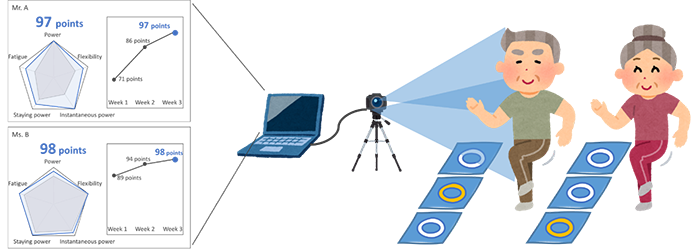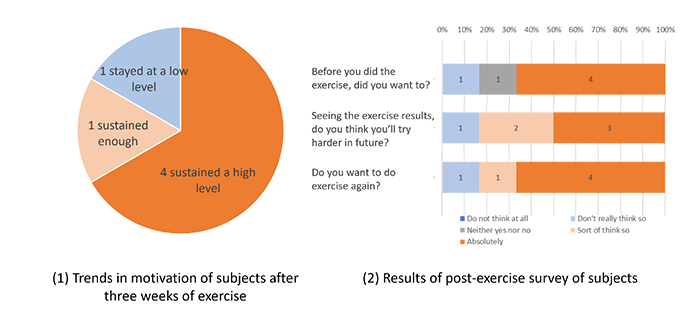Algorithm that corrects measured data with high precision and in real time makes it easy to evaluate exercise with a handy device and support motivation sustainability and exercise program design
December 24, 2021

Fig 1. The use case of the exercise evaluation system
With the aim of achieving a mentally and physically healthy society, Hitachi has developed an exercise evaluation system (Fig. 1) to encourage seniors to continue and enjoy fall prevention training in retirement homes and other aged care facilities. The system measures the position of joints during exercise using a consumer 3D camera and evaluates the exercise from five viewpoints*1—power, flexibility, instantaneous power, staying power, and fatigue— based on musculoskeletal analysis,*2 to determine how the exercise affects seniors. With this system, seniors will have more interest in improving their movement functions and be able to enjoy and continue training. The evaluation system also enables trainers to design exercise programs personalized to each senior, and trainer and senior can engage in daily programs with conversation. Hitachi will conduct verification trials with various customers to enhance the precision of the system and will contribute to QoL*3 improvement for people by making the system widely available as an enjoyable service.
One of the reason seniors become in need of care is falls and fractures caused by loss of muscular strength*4 and continuous muscle training is considered effective in such prevention. Cost reduction of equipment, personalization of exercise program and improvement in seniors’ motivation need to be considered for aged care facilities. Hitachi has developed the exercise evaluation system using a consumer 3D camera to make it easy for seniors to find the effect of exercise, and to sustain their motivation to continue the exercise and maintain their mental and physical health. The features of the system are as described below.
In clinical research and in professional sport analysis, human movement and joint positions are measured in three dimensions using expensive motion capture systems, and the muscle activity during movement is evaluated on the basis of musculoskeletal analysis. In these types of applications, measurement of joint position requires accuracy down to the millimeter. Hitachi's exercise evaluation system, conversely, uses a consumer 3D camera, which can be easily introduced at retirement homes. Such cameras, however, provide varied measurement results and precision will degrade in musculoskeletal analysis. To solve these problems, Hitachi has developed a skeletal coordinates correction algorithm which corrects measured joint position with high precision and in real time on the basis of the structure of the human body and biomechanics. The algorithm corrects skeletal coordinates by solving the problem of optimization, adding the limiting factors of inter-joint length, which is constant during movement because human bones are rigid, and smooth movement of the position of human joints. The technology reduces variations in measurement results by a third compared to without correction. By employing a consumer 3D camera, the evaluation system can be adopted easily and at low cost.
Improving seniors’ motivation is necessary to continue muscle training to prevent falls. The evaluation system evaluates muscle activity just through the simple, fun movement of stepping in time with flashing lights on a panel positioned at the user's feet. The time series data of force and moment*5 on the joint obtained from musculoskeletal analysis is evaluated from five viewpoints—power, flexibility, instantaneous power, staying power, and fatigue. A total score is calculated and displayed on the basis of these parameters. In this way, seniors enjoy exercise like a computer game, and as they are able to follow their daily improvement by comparing current score to past scores, their motivation will be sustained and improved.
Six residents of a retirement home volunteered to participate in the evaluation of this system, and after three weeks, motivation was sustained and improved in five of the six participants(Fig. 2(1)). Positive responses to a survey were received, one of the positive responses was, “I want to do exercise again” (Fig. 2(2)).

Fig 2. Verification results of evaluation system
For more information, use the enquiry form below to contact the Research & Development Group, Hitachi, Ltd. Please make sure to include the title of the article.